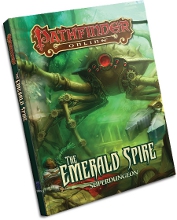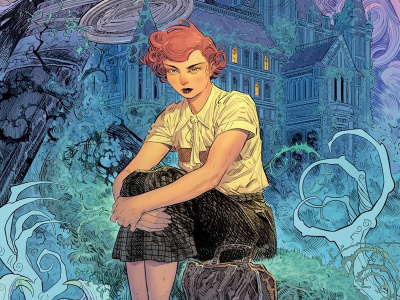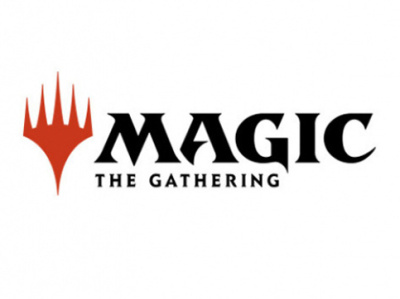 ICv2 caught up with Paizo Publisher Erik Mona just after the GAMA Trade Show to get his views on the RPG market and hear about Paizo’s upcoming releases. In Part 1, we talk about the growth of the RPG industry and how Pathfinder is positioned on the brink of the looming D&D release. In Part 2, we talked about secular change in the RPG market, the new video game, and planned releases shown at GTS.
ICv2 caught up with Paizo Publisher Erik Mona just after the GAMA Trade Show to get his views on the RPG market and hear about Paizo’s upcoming releases. In Part 1, we talk about the growth of the RPG industry and how Pathfinder is positioned on the brink of the looming D&D release. In Part 2, we talked about secular change in the RPG market, the new video game, and planned releases shown at GTS. When the new edition of Dungeons & Dragons is released this summer, the RPG landscape will change. How do you see the current state of the RPG market and how do you think the market will be affected by the launch?
The current state of the RPG market is pretty self-evident: Pathfinder has been enormously successful and has been increasing in popularity since it came out. We’ve sold more copies of the Core Rulebook every year than the year before since year two. (Year one we sold more than year two, but we’ve been growing the numbers every year since then.)
We have 60,000 registered gamers playing in Pathfinder Society campaigns and 350 Pathfinder Society Coordinators around the world. We call them Venture-Captains and Venture-Lieutenants and they help us grow Pathfinder organically in different parts of the world. I think it’s probably easier to find a game of Pathfinder than a game of D&D right now.
Of course when 5th Edition comes out, presumably this summer, there’s definitely going to be a lot of competition for people’s attention in the traditional sword and sorcery RPG realm. We’re aware of that and we are doing the best we can to keep people focused on the game they’re playing currently, which in many cases is Pathfinder.
We’re taking a three-pronged approach to make sure that we have something of interest to current Pathfinder players wherever they fall on the spectrum of dedication and interest. There are a lot of different reasons people enjoy playing fantasy roleplaying games, so we try to do something that appeals to you no matter what interest is primary in your mind.
For example in August, we’re going to be releasing the Pathfinder Advanced Class Guide, which is a hardcover rules expansion that will introduce ten new classes to the Pathfinder game. The idea is if you are a very dedicated Pathfinder player, the kind who is super-excited every time we put out new rules, or maybe you’re someone who feels like they’ve seen it all already, we’ve got ten brand new classes in the Advanced Class Guide. Those were put through a rigorous public play test this winter so there are tens of thousands of people who have tried those classes out and are looking forward to the final edition that will incorporate some of the changes suggested from our play testers.
That’s patterned off the Advanced Players Guide, which is the third bestselling Pathfinder hardcover book we’ve done after the First Bestiary and the Core Rulebook. Anytime we’ve done a significant expansion of the classes in the Pathfinder game, people have stood up and taken notice; that seems to have reinvigorated people’s interest in the game. That’s a major release we’ve got for August.
In June, we’re doing something really interesting called The Emerald Spire Superdungeon. One of the things I suspect will happen when D&D puts out its new edition is that they’ll have to go back to basics. They’ve already said their monster manual will contain all the main monsters. Having just started the ball rolling on a fantasy roleplaying game edition only a few years ago, logic suggests that you start with the orcs and the dragons and the dungeons and all that stuff, so one of the things we’re doing to make sure Pathfinder has an offering for people who are more interested in that more traditional play is the Emerald Spire Superdungeon.
That ties into the Kickstarter campaign that we did last year that raised over $1 million for the Pathfinder Online computer game that the studio, Goblinworks, has in development right now.
Emerald Spire Superdungeon is a 160-page hard cover superdungeon with 16 levels each designed by superstar game designers. We’ve got the most well-known writers here at Paizo, like James Jacobs, our Creative Director; Wes Schneider, our editor-in-chief; Jason Bulmahn, our lead designer, myself, and even Lisa Stevens came out of game design retirement to contribute a level. We also have a lot of luminaries of the game industry as a whole, levels from Ed Greenwood, creator of the Forgotten Realms; Keith Baker, the creator of Ebberon; Frank Mentzer, who put together the Red Box for Dungeons & Dragons back in the ‘80s; Chris Pramas, the president of Green Ronin; and Mike Stackpole. There’s really an impressive list of authors for this thing and each one has brought their own flare to dungeon design.
It’s a lavishly illustrated, full color, straight-on superdungeon. I think that’s going to appeal to people looking to scratch the “let’s bust down the doors and fight monsters” itch. [Note: MSRP is $34.99.]
The last pillar of our plan to maintain people’s interest this summer is taking advantage of something that a more mature rules system can do, and that’s to do some things that are more experimental and a little more out of left field.
In August we’re going to be launching the Iron Gods Adventure Path. It’s an exploration of a part of the world called Numeria, where about one thousand years ago a giant spaceship crashed on the surface of Golarion, our world, and littered space junk and crazy future debris all over this barbarian landscape. Iron Gods has the player characters investigating segments of this crashed spaceship, dealing with technology (still very grounded in a sword and sorcery way) but adding a little bit of super science to things. We’ll be releasing some support books, like a technology guide (see "'Pathfinder Technology Guide'") in the Campaign Setting line that will add science fictional weapons, gear and concepts to Pathfinder.
Iron Gods will go from August to January, and really the central conceit of Iron Gods is what happens when an artificial intelligence associated with the future tech of this ship takes on the characteristics of a god, and people start worshipping this artificial intelligence and granting it deific powers. What does that mean for the world of Pathfinder and specifically for the land of Numeria? We’re doing that campaign in a self-contained way. There’s definitely going to be a lot of players who are not interested in adding any kind of technology to their campaign setting, and like other thematic elements of the Pathfinder Campaign Setting, it is as self-contained as you need it to be. We think there’s going to be a lot of people who are not necessarily interested in going back to the very beginning and are going to be interested in trying new things.
Every time in the past when we’ve done an experimental adventure, or done something that we thought would be controversial like in the Reign of Winter Adventure Path, which we just concluded, where you jump from world to world. Because it involves Baba Yaga and Baba Yaga’s hut, we thought it would be fun to send people back to World War I-era Russia, and they fought against Rasputin, the unkillable Russian monk. That’s been one of the most popular adventures we’ve ever released.
The lesson we took from that is that we’re committed to core fantasy and we’re definitely going to be providing that, as time goes on, very regularly, but when we take a step outside expectations people really respond positively.
With the Advanced Class Guide bringing up new classes and new interesting mechanical options for players, with Emerald Spire providing that classic sword and sorcery dungeon-crawling experience, and then with Iron Gods providing six months of support for 'out-of-left-field, interesting, mature system, thematic exploration,' we feel pretty confident that people will at least continue to look in our direction no matter what else hits the shelves in August, or September, or October, or whenever it turns out to be.
We’ve been hearing from retailers and distributors that only three or four years ago, they couldn’t even think of more than two RPGs, and now they mention up to four or five that are selling well. Do you think the RPG pie is growing, and what do you think will happen when D&D comes back?
I do think the pie is growing. The hegemony of the d20 System that really came up in 2000 was shattered by the fact there wasn’t an open games system license for 4th Edition and that encouraged people to go in their own directions. There’s a crop of new companies that didn’t exist 10 years ago, that weren’t a part of that d20 saturation. A lot of them are doing their own systems and filling niches that were not fillable by the d20 System, so you’ve got a lot of growth.
My sense at GAMA this year was that the industry as a whole is much healthier than it was five or six years ago, so in general there are tons of options for people to have a game that is very much what they want to play, whatever that may be. I definitely think that there are more people buying RPGs and more people playing RPGs than there were five years ago. There’s certainly more people playing Pathfinder than there were five years ago, and I think other companies have seen similar growth.
It’s going to be really interesting to see what happens with D&D. I think Hasbro has an opportunity to get RPGs into certain mass market venues that a lot of companies, even companies as big as Paizo, don’t have those relationships or the ability to take the risk of a huge return from Walmart. In the past Hasbro has shown some ability to do that, and D&D back in its height used to be in every toy store in the country and the Sears catalog. The world’s changed a lot since then, but it’s a great brand and we’ll see what happens.
My hope is that an invigorated new edition of Dungeons & Dragons brings even more people into the hobby. I was at Wizards during the launch of Third Edition and they were putting ads in Maxim magazine. They were really doing significant outreach to lapsed players and to new players in a way that most companies cannot afford to do. My hope is that a new D&D brings new players into the hobby. Whether they’re able to sustain the interest of those new players with subsequent releases is an open question. If some of those people are not going to be satisfied, I’m very happy to have a roleplaying game that ideally will appeal to them as well.
Pathfinder is robustly supported: we’ve got lots of releases (we’re releasing five or six products a month); we do three or four hardcover books a year. This is a full line RPG and for folks who are looking for something that will give you adventures and worlds with lots of different subworlds to appeal to lots of different interests, and we have a worldwide organized play campaign. We have all those things in place. In terms of competition I think we’re as well situated as we could possibly be. We have a lot of faith in our company and a lot of faith in our game. Our fans do not seem to be getting tired of the game; if anything the game is getting more and more popular. It’s going to be an interesting year. We definitely survived the last edition of D&D, I’m pretty sure we’ll survive this one, too.
Click here for Part 2.








